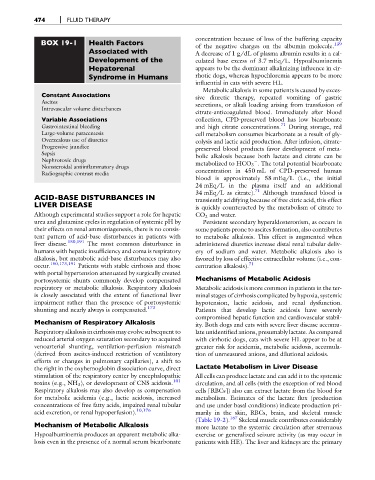Page 486 - Fluid, Electrolyte, and Acid-Base Disorders in Small Animal Practice
P. 486
474 FLUID THERAPY
BOX 19-1 Health Factors concentration because of loss of the buffering capacity
139
of the negative charges on the albumin molecule.
Associated with A decrease of 1 g/dL of plasma albumin results in a cal-
Development of the culated base excess of 3.7 mEq/L. Hypoalbuminemia
Hepatorenal appears to be the dominant alkalinizing influence in cir-
Syndrome in Humans rhotic dogs, whereas hypochloremia appears to be more
influential in cats with severe HL.
Metabolic alkalosis in some patients is caused by exces-
Constant Associations
sive diuretic therapy, repeated vomiting of gastric
Ascites
secretions, or alkali loading arising from transfusion of
Intravascular volume disturbances
citrate-anticoagulated blood. Immediately after blood
Variable Associations collection, CPD-preserved blood has low bicarbonate
Gastrointestinal bleeding and high citrate concentrations. 71 During storage, red
Large-volume paracentesis cell metabolism consumes bicarbonate as a result of gly-
Overzealous use of diuretics colysis and lactic acid production. After infusion, citrate-
Progressive jaundice
preserved blood products favor development of meta-
Sepsis
bolic alkalosis because both lactate and citrate can be
Nephrotoxic drugs
metabolized to HCO 3 . The total potential bicarbonate
Nonsteroidal antiinflammatory drugs
Radiographic contrast media concentration in 450 mL of CPD-preserved human
blood is approximately 58 mEq/L (i.e., the initial
24 mEq/L in the plasma itself and an additional
34 mEq/L as citrate). 71 Although transfused blood is
ACID-BASE DISTURBANCES IN transiently acidifying because of free citric acid, this effect
LIVER DISEASE is quickly counteracted by the metabolism of citrate to
Although experimental studies support a role for hepatic CO 2 and water.
urea and glutamine cycles in regulation of systemic pH by Persistent secondary hyperaldosteronism, as occurs in
their effects on renal ammoniagenesis, there is no consis- some patients prone to ascites formation, also contributes
tent pattern of acid-base disturbances in patients with to metabolic alkalosis. This effect is augmented when
liver disease. 150,191 The most common disturbance in administered diuretics increase distal renal tubular deliv-
humans with hepatic insufficiency and coma is respiratory ery of sodium and water. Metabolic alkalosis also is
alkalosis, but metabolic acid-base disturbances may also favored by loss of effective extracellular volume (i.e., con-
150,173,191 71
occur. Patients with stable cirrhosis and those centration alkalosis).
with portal hypertension attenuated by surgically created
portosystemic shunts commonly develop compensated Mechanisms of Metabolic Acidosis
respiratory or metabolic alkalosis. Respiratory alkalosis Metabolic acidosis is more common in patients in the ter-
is closely associated with the extent of functional liver minal stages of cirrhosis complicated by hypoxia, systemic
impairment rather than the presence of portosystemic hypotension, lactic acidosis, and renal dysfunction.
shunting and nearly always is compensated. 173 Patients that develop lactic acidosis have severely
compromised hepatic function and cardiovascular stabil-
Mechanism of Respiratory Alkalosis
ity. Both dogs and cats with severe liver disease accumu-
Respiratory alkalosis in cirrhosis may evolve subsequent to late unidentified anions, presumably lactate. As compared
reduced arterial oxygen saturation secondary to acquired with cirrhotic dogs, cats with severe HL appear to be at
venoarterial shunting, ventilation-perfusion mismatch greater risk for acidemia, metabolic acidosis, accumula-
(derived from ascites-induced restriction of ventilatory tion of unmeasured anions, and dilutional acidosis.
efforts or changes in pulmonary capillaries), a shift to
the right in the oxyhemoglobin dissociation curve, direct Lactate Metabolism in Liver Disease
stimulation of the respiratory center by encephalopathic All cells can produce lactate and can add it to the systemic
toxins (e.g., NH 3 ), or development of CNS acidosis. 101 circulation, and all cells (with the exception of red blood
Respiratory alkalosis may also develop as compensation cells [RBCs]) also can extract lactate from the blood for
for metabolic acidemia (e.g., lactic acidosis, increased metabolism. Estimates of the lactate flux (production
concentrations of free fatty acids, impaired renal tubular and use under basal conditions) indicate production pri-
acid excretion, or renal hypoperfusion). 10,176 marily in the skin, RBCs, brain, and skeletal muscle
(Table 19-2). 167 Skeletal muscle contributes considerably
Mechanism of Metabolic Alkalosis more lactate to the systemic circulation after strenuous
Hypoalbuminemia produces an apparent metabolic alka- exercise or generalized seizure activity (as may occur in
losis even in the presence of a normal serum bicarbonate patients with HE). The liver and kidneys are the primary

